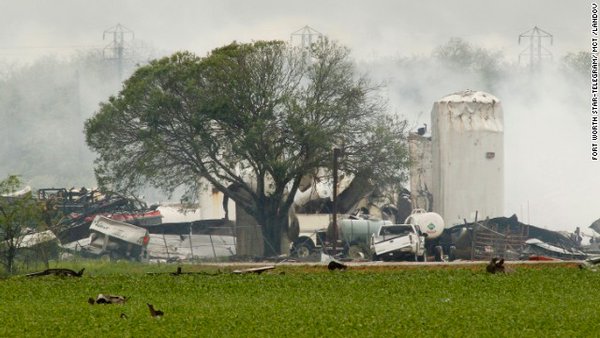
The deadly fire that preceded a massive 2013 explosion at a fertilizer plant in West, Texas, killing more than a dozen people and injuring hundreds, was intentionally set, federal authorities said Wednesday.
Officials from the Bureau of Alcohol, Tobacco, Firearms and Explosives and the Texas State Fire Marshal’s office announced this finding at a news conference Wednesday, more than three years after the massive blast, saying they came to the conclusion after ruling out “all reasonable, accidental and natural causes.”
The sprawling investigation into the cause of the April 2013 fire – and the explosion that followed it about 20 minutes later – spanned more than 400 interviews and cost more than $2 million, according to the ATF. In addition, the agency said it conducted extensive testing at its fire research lab in Beltsville, Maryland. The ATF said it was offering a $50,000 reward for information leading to the arrests of the person or people responsible for the fire.
The fire and explosion at the fertilizer plant leveled homes, killed 15 people and injured more than 200 others. The U.S. Geological Survey reported that the blast registered akin to a magnitude 2.1 earthquake, and the ATF said the crater left behind was 93 feet wide and 12 feet deep.
Doors and roofs were blown off homes by the blast, which ravaged a large portion of West and damaged more than 150 other buildings, including schools, an apartment complex and a nursing home where investigators said many of the people seriously injured in the blast had been living.
Federal investigators later said the fire and explosion was preventable, and that the company, as well as local, state and federal agencies, had failed to identify and avoid a potential hazard.
According to preliminary findings from the Chemical Safety Board, a federal agency that investigates chemical accidents at industrial facilities, volunteer firefighters from West were unaware that the ammonium nitrate stored at the plant constituted another explosion hazard, and that meant they were placed in harm’s way during the blast.
A dozen of the people killed in the explosion were emergency responders.
“These individuals were people serving their community in a volunteer capacity,” Robert Elder, special agent in charge of the ATF’s Houston field division, said at a news conference Wednesday. “They are true community servants. They lost their life serving their community and they deserve the best that we can give them.”
The explosion in West, about 80 miles south of Dallas, was devastating. In a final report issued earlier this year, federal investigators said the blast demolished the plant and sent more than 260 people to nearby hospitals for treatment. They also said that as of January, three possible causes for the fire and subsequent explosion were still being considered: intentional arson, a short circuit in a golf cart and faulty wiring.
A timeline laid out by federal investigators said that someone called 911 to report a sign of fire at about 7:29 p.m. The explosion followed at 7:51 p.m., and most of the people killed in the episode died from blunt force trauma, blast force injuries or fractures, officials said.
One of the people killed lived at the nursing home, while two of the people killed lived at an apartment complex; the other 12 people killed were all emergency responders. The people who survived the blast emerged with cuts, traumatic brain injuries, eye injuries and a variety of other wounds.
(c) 2016, The Washington Post · Mark Berman

